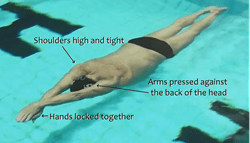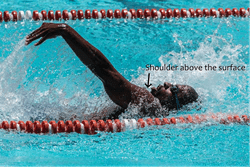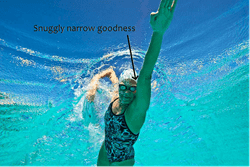How Your Shoulders Might be Slowing You Down
Drag-reduction techniques you might be missing
There are ways to tell a swimmer from a normal person. In addition to their happy smiles, enticing chlorine scent, and closets full of swim-meet T-shirts, swimmers tend to have broader shoulders than the nonaquatic population. I once heard it summed up perfectly by a nonswimming spouse at a Masters team party. She looked around and said “Gee, there sure are a lot of V-shaped people here.”
Yet although you deserve to take well-earned pride in the upper-body musculature your hard work has sculpted, there are times when broad shoulders can get in your way. No, I’m not talking about narrow-gauge spelunking or undersized airline seats. I’m talking about the fact that the wider you are, the more resistance your body creates as it moves through the water.
Let’s talk about how to get those wonderfully powerful shoulders to stay out of your way when you swim.
Flexibility
 Step one is to achieve and retain the shoulder mobility required for streamlining. Do shoulder stretching exercises every day to increase your range of motion. Stand up and assume the streamline position multiple times during each workday to counteract the negative effects of driving, working at a computer, etc. (Don’t worry about funny looks from co-workers; they’re just jealous of your commitment.)
Step one is to achieve and retain the shoulder mobility required for streamlining. Do shoulder stretching exercises every day to increase your range of motion. Stand up and assume the streamline position multiple times during each workday to counteract the negative effects of driving, working at a computer, etc. (Don’t worry about funny looks from co-workers; they’re just jealous of your commitment.)
At the pool, hold a tight streamline every time you leave the wall. Do your kick sets in this position, enjoying the knowledge that any discomfort experienced while holding form will pay off with drag reduction as your shoulders loosen up.
Rotation
Your shoulders can’t create water drag if they’re not in the water. Freestyle and backstroke rotation should raise your shoulder slightly above the surface, reducing drag by reducing the surface presented to the water. Proper kicking technique and holding a tight core help achieve this rotation.
surface presented to the water. Proper kicking technique and holding a tight core help achieve this rotation.
Develop awareness of shoulder movement during recovery to avoid a wide drag profile as you swim. Execute open turns by looking to the side (rather than down the pool) to keep from squaring up your shoulders and catching a ton of water when you push off.
Shoulder Placement
Remember when you were a kid, and you took comfort from cuddling with your teddy bear? (Or whatever. My plush comfort pal was a bright orange 4-foot stuffed boa constrictor. Yours might have been Winnie the Pooh, an Ewok, or a Decepticon robot; no one’s judging here.) You’d press the little darling right up against your cheek to feel that cuddly connection. Well, that’s what you should do with your shoulder at the beginning of each stroke.
Alignment refinement
Placing your shoulder next to your face elevates that joint from where it would be if you stood at attention, and there’s a temptation to lower the opposite shoulder to compensate, which results in a lateral spinal curve. Hold your spinal alignment so that your body is always straight and streamlined, even when that lead shoulder moves forward for the catch.
 Practice correct form by standing on dry land facing a wall. Reach up with one hand to touch the wall at the highest point you can reach without allowing your back to bend to the side. Have a friend watch to ensure you aren’t curving your spine in any direction at all during the extension. When you find the highest point you can reach without distortion, you’ve found the cheek-to-shoulder relationship you want at the beginning of each stroke.
Practice correct form by standing on dry land facing a wall. Reach up with one hand to touch the wall at the highest point you can reach without allowing your back to bend to the side. Have a friend watch to ensure you aren’t curving your spine in any direction at all during the extension. When you find the highest point you can reach without distortion, you’ve found the cheek-to-shoulder relationship you want at the beginning of each stroke.
As your hand and forearm engage the water to begin your pull, notice how your shoulder moves. If it pulls away from your cheek before your acceleration begins, you’ve likely let your elbow drop to a position where your pulling surface will slip. Hold your shoulder next to your cheek a bit longer to ensure an awesome catch.
Swim thin to win
Look for other opportunities to decrease the width of your shoulders.
- Breaststroke pullouts—Round your shoulders and keep your arms close to your body during your underwater pull and recovery to maintain speed and increase glide distance.
- Breathing—Shoulder position during breathing (in any stroke) also provides feedback about head movement. If your underwater shoulder doesn’t remain near your head when breathing in freestyle, you may be lifting your head to a position that distorts your alignment. In breaststroke, both shoulders should approach your face to ensure a narrow profile as you thrust your arms forward after breathing.
- Feedback from the feet—If your kick is wide or asymmetrical, it could be caused by poor shoulder position. Crossover during recovery (misalignment of your shoulder plane) ripples through the body to result in a scissor kick or a telltale “kerthump” from a foot that’s out of alignment. Inadvertently kicking the lane rope is a reminder to check your shoulder position.
Categories:
- Technique and Training
SIGN UP FOR UPDATES FROM USMS

















